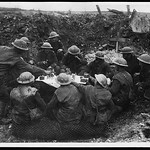Food and World War One

Food during the Great War was the topic under investigation this morning as library staff attended an end of term talk.
It’s become a bit of a tradition that during the last week of each term, our staff development events are replaced with talks on topics of interest, and this mornings was inspired by the upcoming centenary of the outbreak of war.
Previous topics have included Food on The Titanic, Food in Children’s Literature, Easter Foods, Christmas Foods, Honey, Spices, Chocolate… Yes, there’s a theme, and yes, these sessions always include tasty examples of the foods being discussed.
As a presenter, I really value the opportunity to keep my public speaking skills up to date by running these sessions. In my day to day role it doesn’t happen that often, so I’m very grateful to have this chance a couple of times a year. I’m also lucky enough to have some great people to work with on them, not least our resident baker!
This morning I was able to share information, photos and videos about mobile field kitchens, trench food, rations and the Home Front. I used personal accounts, official documents and archive material to illustrate the topic, all sourced from our print and e-resources here in the library.
There was potato bread, mock crab, Anzac biscuits and 1916 trench cake to sample, all of which were given the nod of approval from around the table. To finish, a short talk on the model of Messines uncovered at Cannock Chase was given by our Map Librarian (map of Belgium in hand, obviously).
In a schedule which is often jam-packed with courses, training and the sheer hard work of day to day tasks, having this interlude in which people from across the library can get together and learn something new, experience something different or share something interesting is both a privilege and a pleasure. It reminds us that we’re part of a huge world of information, and that often, a little digging amongst resources we already have can illuminate this in a whole new way.
Photos by National Library of Scotland (public domain).




Leave a Comment (note: all comments are moderated)